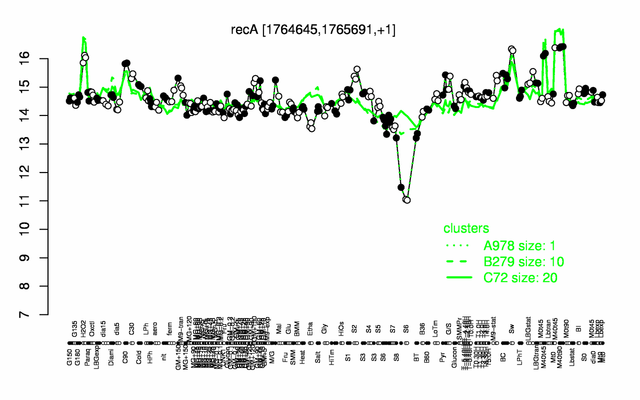Difference between revisions of "RecA"
| Line 102: | Line 102: | ||
* '''[[Localization]]:''' | * '''[[Localization]]:''' | ||
| − | ** | + | ** colocalizes to the [[replisome]] in response to endogenous and exogenous DNA damage {{PubMed|24891441}} |
** Nucleoid (Mid-cell) [http://www.ncbi.nlm.nih.gov/sites/entrez/16479537 PubMed] | ** Nucleoid (Mid-cell) [http://www.ncbi.nlm.nih.gov/sites/entrez/16479537 PubMed] | ||
** localizes to one cell pole {{PubMed|21278288}} | ** localizes to one cell pole {{PubMed|21278288}} | ||
| Line 171: | Line 171: | ||
<pubmed> 14527291 12045091 10506835 14616075 21517913 23046409 23380520 22933559 </pubmed> | <pubmed> 14527291 12045091 10506835 14616075 21517913 23046409 23380520 22933559 </pubmed> | ||
==Original publications== | ==Original publications== | ||
| − | <pubmed>11814663,16061691,19060143,17803906,16024744,17630974,8226626,11555642, 16479537 19730681 7690748 17229847,16267290 20509597 20723756 17449621 21278288 22373918 22517742 23284295 23536821 21859751 23634894 23779106 24285298 24285298 24373815 15378759 24362571 8899710 24670664 </pubmed> | + | <pubmed>11814663,16061691,19060143,17803906,16024744,17630974,8226626,11555642, 16479537 19730681 7690748 17229847,16267290 20509597 20723756 17449621 21278288 22373918 22517742 23284295 23536821 21859751 23634894 23779106 24285298 24285298 24373815 15378759 24362571 8899710 24670664 24891441 </pubmed> |
[[Category:Protein-coding genes]] | [[Category:Protein-coding genes]] | ||
Revision as of 10:49, 4 June 2014
- Description: multifunctional protein involved in homologous recombination and DNA repair (LexA-autocleavage)
| Gene name | recA |
| Synonyms | recE |
| Essential | no |
| Product | multifunctional protein involved in homologous recombination and DNA repair (LexA-autocleavage) |
| Function | DNA repair/ recombination |
| Gene expression levels in SubtiExpress: recA | |
| Interactions involving this protein in SubtInteract: RecA | |
| MW, pI | 37 kDa, 4.883 |
| Gene length, protein length | 1041 bp, 347 aa |
| Immediate neighbours | cinA, pbpX |
| Sequences | Protein DNA DNA_with_flanks |
Genetic context 
This image was kindly provided by SubtiList
| |
Expression at a glance PubMed
| |
Contents
Categories containing this gene/protein
DNA repair/ recombination, genetic competence, phosphoproteins, most abundant proteins
This gene is a member of the following regulons
The gene
Basic information
- Locus tag: BSU16940
Phenotypes of a mutant
- drastically reduced survival of mature dormant spores after exposure to ultrahigh vacuum desiccation and ionizing radiation that induce single strand (ss) DNA nicks and double-strand breaks (DSBs) PubMed
Database entries
- BsubCyc: BSU16940
- DBTBS entry: [1]
- SubtiList entry: [2]
Additional information
RecA filaments are dismantled from DNA by PcrA PubMed
The protein
Basic information/ Evolution
- Catalyzed reaction/ biological activity:
- Protein family: recA family (according to Swiss-Prot)
- Paralogous protein(s):
Extended information on the protein
- Kinetic information:
- Effectors of protein activity:
Database entries
- BsubCyc: BSU16940
- Structure: 1U94 (RecA from E. coli, 62% identity, 86% similarity)
- UniProt: P16971
- KEGG entry: [3]
- E.C. number:
Additional information
Expression and regulation
- Operon: recA PubMed
- Regulation:
- Additional information:
- belongs to the 100 most abundant proteins PubMed
- number of protein molecules per cell (minimal medium with glucose and ammonium): 417 PubMed
- number of protein molecules per cell (complex medium with amino acids, without glucose): 1257 PubMed
- number of protein molecules per cell (minimal medium with glucose and ammonium, exponential phase): 5143 PubMed
- number of protein molecules per cell (minimal medium with glucose and ammonium, early stationary phase after glucose exhaustion): 3169 PubMed
- number of protein molecules per cell (minimal medium with glucose and ammonium, late stationary phase after glucose exhaustion): 4953 PubMed
Biological materials
- Mutant:
- IRN444 (cat), available in Jörg Stülke's lab
- 1A746 (recA::erm), PubMed, available at BGSC
- 1A786 (recA::kan), PubMed, available at BGSC
- BP469 (recA::erm), available in Fabian Commichau's lab
- Expression vector: for expression, purification in E. coli with N-terminal His-tag, pRSETA available in Ulf Gerth's lab
- lacZ fusion:
- GFP fusion:
- two-hybrid system:
- Antibody:
Labs working on this gene/protein
Peter Graumann, Freiburg University, Germany homepage
Your additional remarks
References
Reviews
Original publications